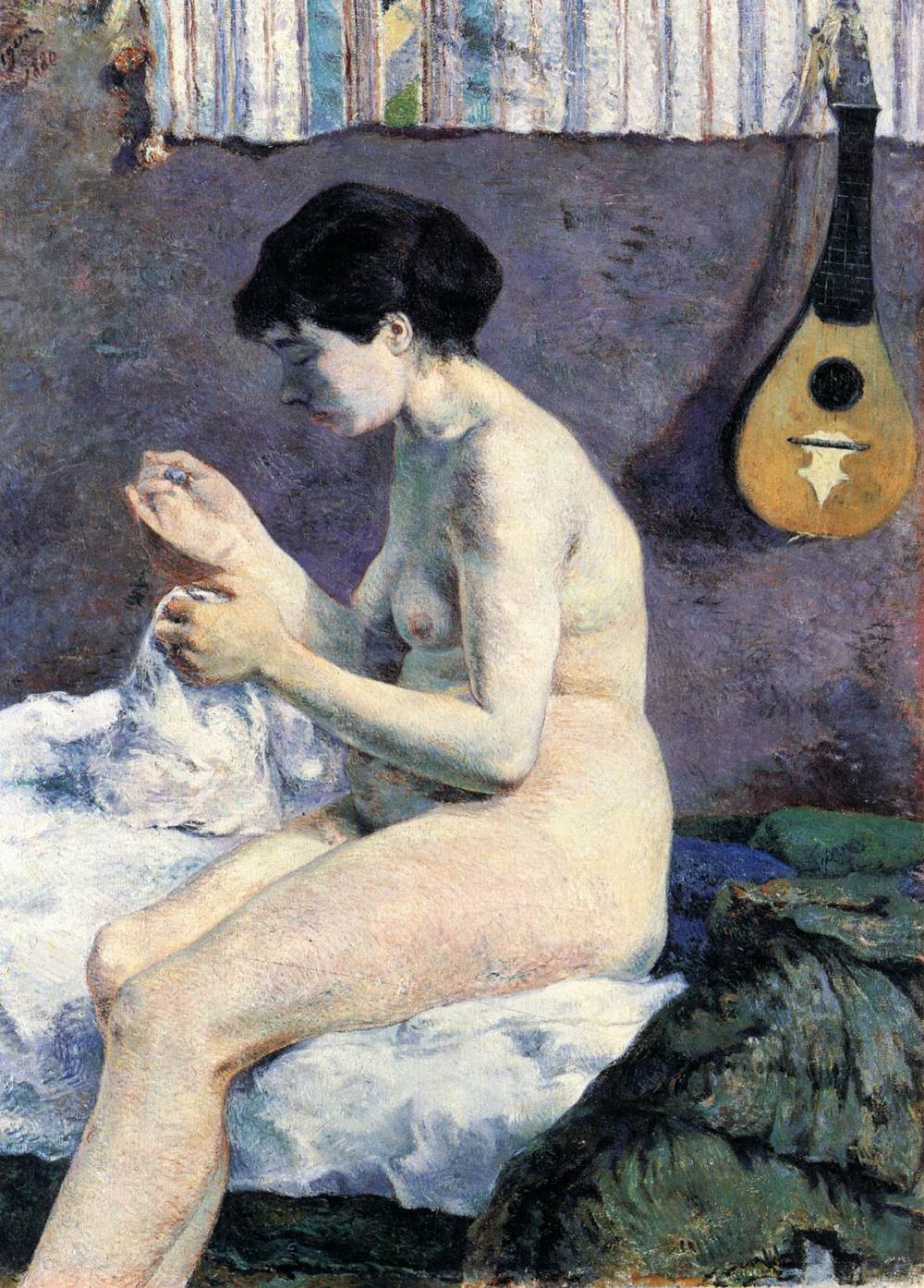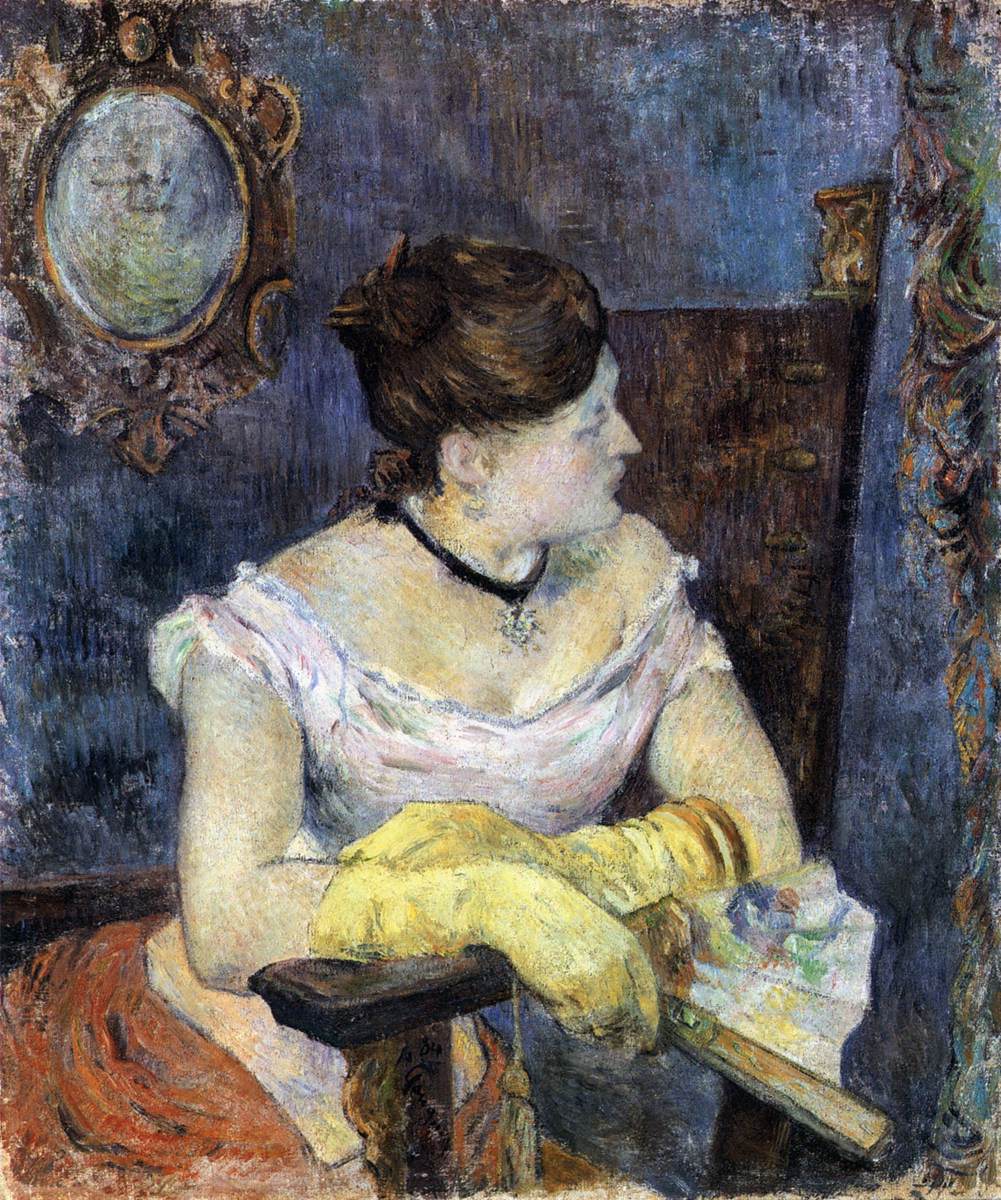Eugene-Henri-Paul Gauguin, French painter, sculptor, and printmaker. He was the son of Clovis Gauguin, a liberal journalist from Orléans and Aline Chazal, a French-Peruvian (Creole) mother. He spent his childhood in Lima, Peru, between 1851 and 1855. In 1865 he entered the Navy and became an assistant pilot in the Merchant Marine. He traveled the Atlantic Ocean between Le Havre and Rio de Janeiro. An officer on board gave him a glowing account of the two years he had spent in Polynesia.
In 1871 he resigned from the Navy and found a job on the Paris Stock Exchange with the firm Bertin as stockbroker. He made a considerable fortune and led the life of a well-to-do bourgeois. He met Émile Schuffenecker and took up painting with him in his spare time.
In 1873 Gauguin married Mette-Sophi Gaad, from Denmark. The couple had five children, Émile (born 1874), Aline (Gauguin's favourite daughter, born 1877), Clovis (born 1879), Jean-René (born 1881), Pola (born 1883).
In 1874 Gauguin enrolled as a student in the Académie Colarossi (an art school founded by the Italian sculptor Filippo Colarossi in Paris). Soon he started to collect paintings. By 1880 he had his own studio, and his art collection included works by all the Impressionists. He showed one sculpture and seven oil paintings at the Impressionist exhibition in that year, his Study of a Nude (Suzanne Sewing) was favourable reviewed.
In spite of Monet's and Renoir's protest, Gauguin showed eight paintings and two sculptures at the Impressionist exhibition in 1881, and one sculpture and twelve paintings in 1882. These works were harshly criticised.
In 1883 Gauguin and Schuffenecker lost their job at Bertin. Gauguin regarded it as an opportunity to dedicate himself to art. He worked with Pissarro at Osny, and in 1884 at Rouen. Due to the growing financial difficulties, he sent his family to Copenhagen in July, and join then in November to stay near her family. He left for Copenhagen in 1885, where he unsuccessfully pursued a business career. He returned penniless to Paris and led a life of extreme poverty, working at odd jobs.
In 1886 Gauguin took part in the 8th Impressionist exhibition with one sculpture and eighteen paintings revealing Pissarro's influence. he spent the summer at Pont-Aven, Brittany, where he met Émile Bernard. Gauguin coined the term Synthetism to describe his style during this period, referring to the synthesis of his paintings' formal elements with the idea or emotion they conveyed. He returned to Paris, where he met Vincent van Gogh. Increasingly, Gauguin turned to primitive cultures for inspiration.
In April 1887 Gauguin sailed to Panama and later Martinique with the painter Charles Laval. He returned to France in December and stayed with Schuffenecker.
In 1888 Gauguin came into his own style during his second stay at Pont-Aven with Émile Bernard. He met there Paul Sérusier. Theo van Gogh organized his first one-man show exhibiting his ceramics and paintings from Martinique and Brittany. He left for Arles in October, where he stayed for two months with Vincent van Gogh. The style of the two men's work from this period has been classified as Post-Impressionist because it shows an individual, personal development of Impressionism's use of colour, brushstroke, and nontraditional subject matter. He returned to Paris when van Gogh went mad and stayed with Schuffenecker.
In 1889 he paintings of Martinique, Brittany and Arles at the exhibition of the Peintres Impressionists et Synthétists in Paris, then he took part in the Salon des XX in Brussels. He returned to Pont-Aven in April and in October he settled at Le Pouldu.
In 1891 he sold thirty paintings to raise money for his trip to Tahiti. Increasingly focused on rejecting the materialism of contemporary culture in favour of a more spiritual, unfettered lifestyle, in June 1891 he settled in Tahiti from where he returned to Paris in August 1893. He painted some of his finest paintings there. Durand-Ruel organized a one-man show at which he showed his Tahiti paintings. The show made a profound impression on the Nabis painters.
In 1894 he stayed again in Pont-Aven and Le Pouldu with Annah the Javanese. He executed woodcuts and experimented with watercolour transfer monotypes. He returned to Paris where Annah disappeared after having stolen all the valuables from Gauguin's studio.
In 1895 he returned to Tahiti and built a large house in the native style. He lived in a great solitude and physical suffering. He worked on Noa Noa, an autobiographical novel set in Tahiti, which was published in 1897. His works were shown at the fourth Salon de la Libre Esthétique in Brussels. In 1898 he attempted suicide which was followed by a period of great productivity.
In 1900 he was seriously ill, with no money for medical treatment. His works were included in the Centennial Exhibition of French Art 1800-1889 at the World Fair.
In August 1901 he moved to Atuona, on the island of Hiva Oa, Marquesas Islands, French Polynesia. In 1903 he was sentenced to three months imprisonment for protesting the authorities' treatment of the natives. He died on May 8 1903.
A Gauguin retrospective was organised at the Salon d'Automne with 227 works in 1906.
Assessment
Gauguin's style developed from Impressionism through a brief cloisonnist phase (in partnership with Émile Bernard) towards a highly personal brand of Symbolism, which sought within the tradition of Pierre Puvis de Chavannes to combine and contrast an idealized vision of primitive Polynesian culture with the sceptical pessimism of an educated European. A selfconsciously outspoken personality and an aggressively asserted position as the leader of the Pont-Aven group made him a dominant figure in Parisian intellectual circles in the late 1880s. His use of non-naturalistic colour and formal distortion for expressive ends was widely influential on early 20th-century avant-garde artists.
//
![]()









